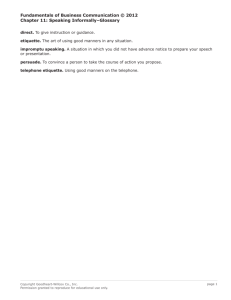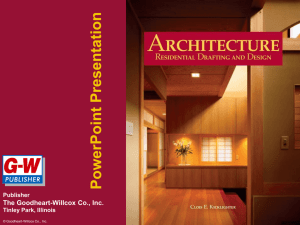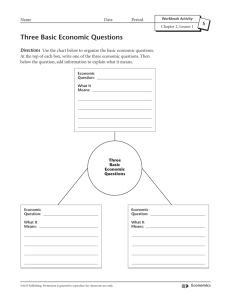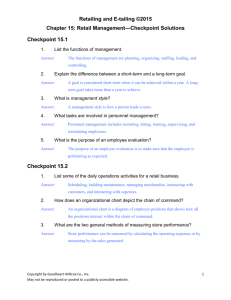ch08
advertisement
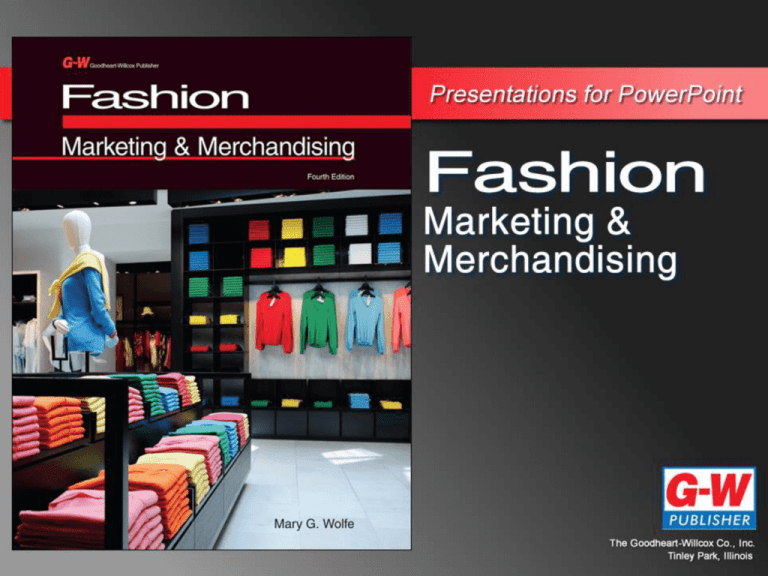
Using Design in Fashion Objectives • Explain the importance of each element of design in relation to fashion. • Apply the principles of design to apparel. • Describe how harmony is achieved in garment designs. • Discuss how to use design to create illusions that enhance appearance. © Goodheart-Willcox Co., Inc. Permission granted to reproduce for educational use only. Design • Design is a plan that puts an idea together • The elements of design are color, shape, line, and texture – Combined in different ways, they form designs • The principles of design are balance, proportion, emphasis, and rhythm – Design harmony results when the elements are combined effectively © Goodheart-Willcox Co., Inc. Permission granted to reproduce for educational use only. Using the Elements of Design • In fashion, the design elements are combined according to current trends • How design elements are used – distinguishes garments from each other – can influence the sale of garments – can reflect the fresh new looks of each season • Color is the most exciting design element © Goodheart-Willcox Co., Inc. Permission granted to reproduce for educational use only. Color • Color has three dimensions or descriptive qualities – Hue is the name given to a color, such as blue, red, or green – Value is the lightness or darkness. A tint is whiter than the pure hue; a shade is darker – Intensity is the brightness or dullness of a color continued © Goodheart-Willcox Co., Inc. Permission granted to reproduce for educational use only. Color • Black, white, and gray are neutrals; they have no hue – Neutrals can be used alone or with almost any colors – White reflects light – Black absorbs all light • Beige is also considered a neutral color since it can be used with most colors © Goodheart-Willcox Co., Inc. Permission granted to reproduce for educational use only. Using the Color Wheel • The color wheel shows the hues and their relationships – Primary hues are red, yellow, and blue – Secondary hues—orange, green, and violet— appear between the primary hues – Intermediate hues appear between each primary and secondary color • A color wheel also shows warm and cool colors © Goodheart-Willcox Co., Inc. Permission granted to reproduce for educational use only. Warm and Cool Colors • Warm colors—red to yellow hues – represent fire, sun, and brilliance – give a feeling of activity, cheerfulness, and liveliness – can convey a nervous impression if overdone • Cool colors—green to violet hues – represent water and the sky – give a restful, calm, relaxed feeling – can convey a depressing mood if overdone © Goodheart-Willcox Co., Inc. Permission granted to reproduce for educational use only. Color Schemes • Color schemes are ways that colors can effectively be used together • Monochromatic color scheme—uses different tints, shades, and intensities of one color • Analogous color scheme—uses adjacent, or related, colors on the color wheel • Complementary color scheme—uses hues that are directly across from each other on the color wheel continued © Goodheart-Willcox Co., Inc. Permission granted to reproduce for educational use only. Color Schemes • Split-complementary color scheme—uses three colors by combining one color with the color on each side of its complement • Triad color scheme—combines three colors equidistant on the wheel, such as red, yellow and blue • Accented neutral color scheme—combines white, black, gray, or beige with a bright color accent © Goodheart-Willcox Co., Inc. Permission granted to reproduce for educational use only. Fashion Insights • Colors can appear to change the size and shape of the person wearing them – A single color, or all close values, for an entire outfit makes a person look thinner and taller – Dark, dull colors minimize attention – To emphasize the best physical features, a small amount of a light or bright color can be used in an advantageous location continued © Goodheart-Willcox Co., Inc. Permission granted to reproduce for educational use only. Fashion Insights • Outfits are generally more attractive if areas of light and dark are not equal • From a distance, the colors in narrow stripes and small plaids blend together • Colors appear to change when viewed under different lights – To get a true color match, it may be necessary to view items in natural light © Goodheart-Willcox Co., Inc. Permission granted to reproduce for educational use only. Shape • Shape is the silhouette, or the overall form or outline of an outfit – Full, wide, flaring shapes add width, making people look larger – Compact silhouettes make people look smaller • Consider facial shapes in relation to apparel neckline designs – If facial shape is extreme in any way, the neckline should not repeat it © Goodheart-Willcox Co., Inc. Permission granted to reproduce for educational use only. Line • Line is a distinct, elongated mark as if drawn by a pen – It leads the path of eye movement, outlining the inner and outer spaces to form the details of a fashion garment • In fashion, structural lines are formed when garments are constructed – such as at seams or darts continued © Goodheart-Willcox Co., Inc. Permission granted to reproduce for educational use only. Line • Decorative lines, or applied lines, are created by adding details to the surface of clothing – such as applied edgings, topstitching, and buttons, or accessories such as scarves and necklaces • Decorative lines often accentuate structural lines – Too much detail causes competition between the lines and is confusing and unattractive © Goodheart-Willcox Co., Inc. Permission granted to reproduce for educational use only. Line Types and Directions • Lines are – straight, curved, or jagged – in 3 basic directions: vertical, horizontal, diagonal • Straight lines are bold and severe, suggesting dignity, power, and formality • Curved lines are less conservative, formal, and powerful than straight lines continued © Goodheart-Willcox Co., Inc. Permission granted to reproduce for educational use only. Line Types and Directions • Jagged lines change direction abruptly in zigzag patterns • Vertical lines give the impression of height and slimness • Horizontal lines go from side to side, giving a relaxed, calm feeling • Diagonal lines slant, drawing attention to the area where they are used © Goodheart-Willcox Co., Inc. Permission granted to reproduce for educational use only. Texture • Texture is the tactile quality of goods or the feel and look of a material’s surface – Structural texture is determined by the fibers, yarns, and method of fabric construction – Added visual texture is achieved by the finishes and designs applied to the surface • Added visual texture is often more noticeable than the structural texture of a fabric continued © Goodheart-Willcox Co., Inc. Permission granted to reproduce for educational use only. Texture • Combinations of textures can be attractive if not too many are combined in one outfit • Texture can create illusions in apparel – Shiny textures emphasize body contours and can make people look larger • Large, bold visual patterns intensify emphasis and increase the apparent size of the wearer © Goodheart-Willcox Co., Inc. Permission granted to reproduce for educational use only. Using the Principles of Design • A garment with good design – is pleasing to the eye – makes the wearer look his or her best – combines the design elements well, according to the principles of design • Combining design elements and principles well achieves harmony, the goal of design © Goodheart-Willcox Co., Inc. Permission granted to reproduce for educational use only. Balance • Balance produces equality among the parts of a design or outfit • It implies equilibrium or steadiness among the parts • Balance in garments is produced by – structural parts and added decoration – good fabric design © Goodheart-Willcox Co., Inc. Permission granted to reproduce for educational use only. Examples of Balance • A larger area of fine or soft texture balances a smaller area of heavy or coarse texture • Warm and dark colors appear heavier than cool and light ones • A small amount of a bright color balances a large amount of a dull one • Large amounts of tints or neutrals balance smaller areas of shades or bright colors © Goodheart-Willcox Co., Inc. Permission granted to reproduce for educational use only. Formal and Informal Balance • Formal balance is symmetrical, with one side identical to the other – It has a dignified and formal appearance • The human figure has formal balance • Informal balance creates equilibrium with an asymmetrical arrangement of design details – It is more subtle and casual than formal balance and usually more interesting © Goodheart-Willcox Co., Inc. Permission granted to reproduce for educational use only. Proportion • Proportion is the spatial, or size, relationship of all the parts in a design to each other and to the whole – This is sometimes called scale • Proportion is most pleasing when areas are divided unevenly – Example: short jackets with long skirts continued © Goodheart-Willcox Co., Inc. Permission granted to reproduce for educational use only. Proportion • To achieve a pleasing proportion for fashions, relate apparel items to the correct proportion of the person wearing it – Buttons, trimming, and pocket size should relate to the overall size of the garment – Large plaids will overpower a small frame • Fashions that emphasize natural body proportions are usually flattering and pleasing © Goodheart-Willcox Co., Inc. Permission granted to reproduce for educational use only. Emphasis • Emphasis is a concentration of interest in a particular part or area of a design – Without a main focal point, an outfit looks unplanned and monotonous • Emphasis can be used to draw attention to an attractive personal feature – Color or texture contrasts as well as accessories can create emphasis © Goodheart-Willcox Co., Inc. Permission granted to reproduce for educational use only. Rhythm • Rhythm is the pleasing arrangement of design elements to produce a feeling of continuity or easy movement – Repetition, gradation, and radiation are the main ways to create rhythm in fashions • Repetition repeats lines, shapes, colors, or textures in a garment – Examples: pleats or a row of buttons continued © Goodheart-Willcox Co., Inc. Permission granted to reproduce for educational use only. Rhythm • Gradation is a gradual increase or decrease of similar design elements, also called progression – Examples: light to dark color, fine to coarse texture • Radiation is created by lines emerging from a central point like rays – Examples: gathers, tucks, seams, darts, flowing lines, or colors fanning outward from an area © Goodheart-Willcox Co., Inc. Permission granted to reproduce for educational use only. Harmony • Harmony is pleasing visual unity created by a tasteful relationship among all parts – Nothing looks out of place • Garments that have harmony are pleasing to the eye and suit the wearer – There is enough variation to be interesting, but not clash – Accessories can be used to create harmony © Goodheart-Willcox Co., Inc. Permission granted to reproduce for educational use only. Illusions Created by Design • The relationship among the different parts of the human form is called body build – The shape of a female’s body is called her figure – The shape of a male’s body is called his physique • By using design elements and principles cleverly, body features can be accentuated or hidden as desired continued © Goodheart-Willcox Co., Inc. Permission granted to reproduce for educational use only. Illusions Created by Design • Designers can use certain styles for desired illusions to flatter various body builds – Example: A-line skirts can hide wide hips • Fashion professionals know how to help others with their clothing selections – Every aspect is important for an entire visual effect from head to toe © Goodheart-Willcox Co., Inc. Permission granted to reproduce for educational use only. In Summary • Color is often the most important design element • The shape of garments influences the illusion of size • Lines in a design lead the eye of the observer • Texture can add interest and appeal to apparel • Balance gives equilibrium to a design continued © Goodheart-Willcox Co., Inc. Permission granted to reproduce for educational use only. In Summary • Proportion relates parts of a design to each other and to the whole • Emphasis is created with a focal point • Rhythm produces a feeling of continuity of movement in a design • Design elements are used to create pleasing visual harmony © Goodheart-Willcox Co., Inc. Permission granted to reproduce for educational use only.
